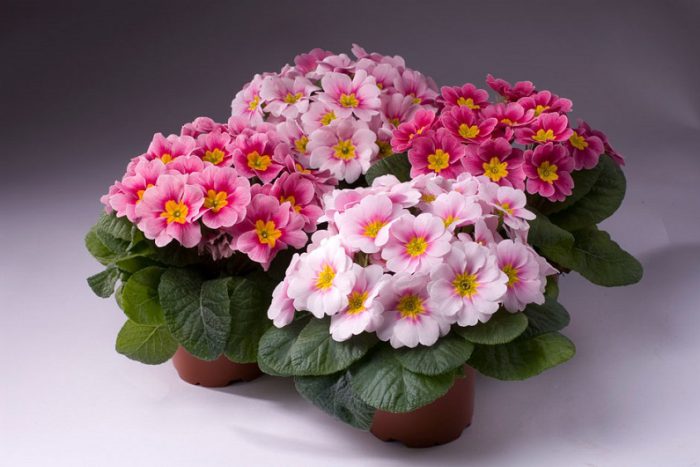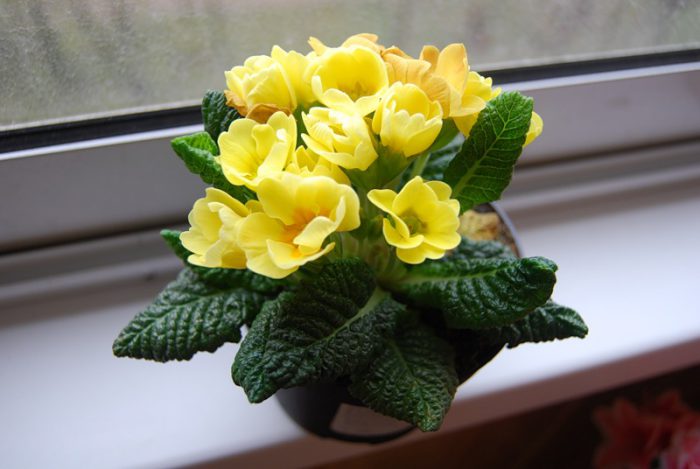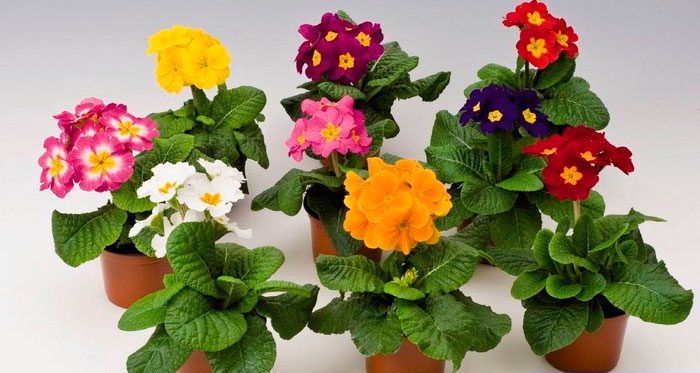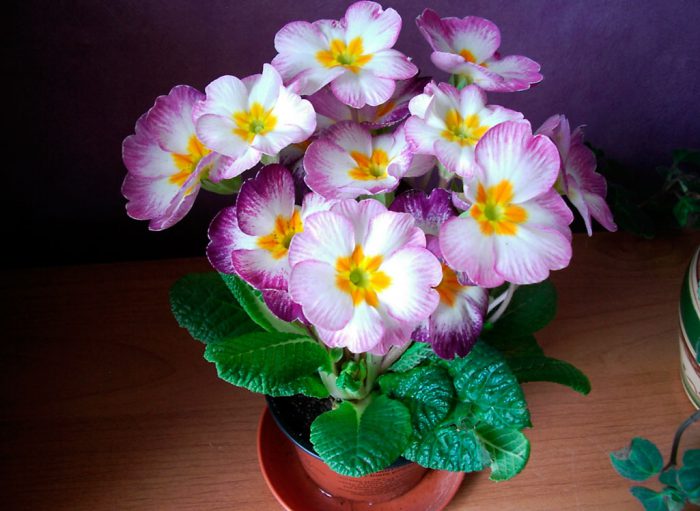In the last winter weeks, spectacular flowering plants appear on sale, which are called primroses... Their flowers can be painted in a variety of colors, and they are located in the middle of the rosette of green leaves, which cannot but please with its spring freshness.
A plant such as primrose (Primula), which is also called a primrose, is directly related to the family of primroses (Primulaceae). This plant is herbaceous and can be found in the wild in temperate regions such as Europe, North America, Asia, and China. This genus unites more than 500 species of plants, among which there are both perennial and annual.
The leaves of this plant are collected in a root rosette. They are covered with a small pile or wrinkled, as well as heart-shaped, and they are located on long petioles with jagged edges.
Primrose flowers can be painted in a wide variety of color shades. The flowers are either collected in umbellate or racemose inflorescences, or are solitary. This plant blooms for a long time.
Primrose is grown like a garden plant, and flowers appear on it at the very beginning of spring, which is why they are also called primroses. This plant is medicinal and has long been used for the preparation of various medicinal products. So, tea made from flowers is drunk in order to strengthen the nervous system. Soothing and diaphoretic decoctions are also made. And even in spring, salads are prepared from young primrose leaves. And that's all, because only 1 leaf of this flower is able to saturate the body with the daily norm of vitamin C.
You should also know that there are indoor species of such a plant that can cause allergies (most often it is obconica). When working with such primroses, flower growers notice that irritation or a rash appears on their hands. In this regard, these flowers are recommended to be placed out of the reach of small children.
At home, perennial primrose obconica is often grown, as well as a large number of different hybrids of garden primrose.
A herbaceous plant such as primrose obconica is perennial and has leaves with a pubescent surface. The leaves, which can be up to 10 centimeters long, have a rounded shape and wavy edges, they are located on long petioles. The flowers collected in umbellate inflorescences are colored pink, blue, white, red or purple.
In indoor conditions, garden primrose is grown as a forcing plant, and it is often they are found on sale at the very end of the winter period. Such garden hybrids practically do not cause an allergic reaction. When the plant has faded, it can be planted in open ground.Most of these species successfully winter at home and bloom for several years.
Content
Primrose care at home
This is a fairly undemanding indoor plant to care for. It is recommended to place it in a well-lit place, and also not to flood it too much, so that rot does not form.
Temperature regime
It is recommended to keep in a cool place. So, when a plant blooms, it needs a temperature of about 12-15 degrees. Primrose obconica prefers a higher temperature (16–20 degrees). After it has faded, it is moved to a cool room or transplanted into open ground, while choosing a shaded place. In the last weeks of the summer, the obconica primrose must be brought into the room.
Illumination
Prefers diffused light. The scorching rays of the sun can harm this flower.
Humidity
There are no special requirements for air humidity. However, if it is too low, then in some species of primrose the edges of the leaves begin to dry. Systematic spraying of foliage is recommended, and you need to use soft water for this.
How to water
When the plant blooms, it is watered often enough, since the ground must be slightly moistened all the time. But it should be borne in mind that it is not necessary to fill it, as this can lead to the formation of rot on the roots. When flowering ends, the plant is watered moderately. Use soft water for irrigation.
Top dressing
You need to start feeding the primrose only after the buds are formed. To do this, use a weak solution of complex fertilizer with trace elements. The plant is fed until the end of the flowering period 2 times a month. It is not recommended to fertilize until the buds appear, since only foliage will grow intensively.
Transfer
After the garden primroses have faded, they are transplanted into open ground. Those plants that remained in the house must also be transplanted and at the same time their daughter sockets must be divided.
Earth mix
For planting, a soil mixture consisting of leaf and peat soil, as well as sand taken in equal proportions, is suitable. Primrose obconica requires the addition of 1 share of turf. Don't forget a good drainage layer.
How to propagate
The primrose can be propagated by seeds, as well as by dividing the bush, which is produced during plant transplantation.
Seeds are usually obtained using artificial pollination. Sowing is carried out in June or July and a wide, low capacity is chosen for this. Sprinkle the seeds with a thin layer of light moist earth (about 2 millimeters thick). Then they are covered with glass or foil. The container with seeds must be kept in a shaded place, in which the temperature will be between 15 and 18 degrees. After a couple of weeks, the first shoots should appear.
You can also propagate primrose and division. To do this, in the springtime, you need to separate the side shoots and plant them in a box filled with sand. From above, they should be covered with polyethylene film or a glass jar. When they take root, you need to transplant in separate pots. It is recommended to cover an adult primrose with moistened moss in the spring, after a while layers should appear. When they develop roots, these layers should be transplanted into separate pots.
Almost all garden primroses, after they are planted in open ground, grow rapidly, while they have many outlets.
Diseases and pests
Can settle aphid and spider mite... Insecticide treatment is recommended.
Forcing primrose
For distillation, as a rule, they take a two-year-old bush or an older divided plant.The flower must be dug out just before the frost, while it must be taken with a large lump of soil. The primrose can be immediately planted in a flower pot or stored in a drawer. For storage, plants are placed in a greenhouse, closed for the winter with frames and dry foliage, or in a basement. The temperature there should be about 4-8 degrees. If it is warmer or lighter, then only foliage will grow intensively. At the same time, the development of buds will be slow or completely absent. There is no need to water the plants.
In the last weeks of January, the first - February, you need to put the primrose in a bright room, where the temperature will be no more than 18 degrees. In this case, watering should be resumed gradually. There are species that begin to bloom in February, others appear in March or April. To prolong flowering, you need to place the primrose in a room with a temperature no higher than 10-15 degrees.
After flowering, these plants are not thrown away. They are placed in a bright, cool place and provide moderate watering. In the spring they are transplanted into the garden. After 2 or 3 years, these primroses can be divided again and used for forcing.

















